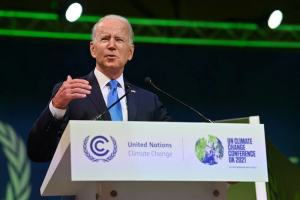The Biden administration on Wednesday, March 20, 2024, unveiled drastic climate regulations designed to phase out gas cars and ensure the majority of passenger vehicles and light trucks sold in the U.S. by 2032 are electric or hybrid.

It represents one of the most significant parts of its ambitious climate agenda as it imposes tight rules on tailpipes that it says will halve greenhouse gas emissions from cars.
But in a concession to automakers and labour unions the regulations will be rolled out more slowly than originally proposed.
The rules come as sales of electric vehicles, which are needed to meet the standards, have begun to slow.
“Three years ago, I set an ambitious target: that half of all new cars and trucks sold in 2030 would be zero-emission,” said President Joe Biden. ‘Together, we’ve made historic progress.
“Hundreds of new expanded factories across the country. Hundreds of billions in private investment and thousands of good-paying union jobs. And we’ll meet my goal for 2030 and race forward in the years ahead.”
Environmentalists, such as the Sierra Club, were quick to welcome the move.
But oil industry representatives called on Congress to block the standards and Republicans condemned the changes as removing choice from consumers.
The Trump campaign posted on X: “Crooked Joe Biden’s insane and radical EV mandates will ban your gasoline-powered vehicles and force you to buy expensive and unreliable electric vehicles.
“President Trump will always protect your freedom to drive what you want.”
Transportation is the largest source of domestic greenhouse gas emissions, with passenger cars (technically known as light duty vehicles) making the biggest contribution.
Auto manufacturers warned of lower sales growth when the EPA announced its proposals in April last year as part of its ambitious plan to cut planet-warming emissions from passenger vehicles.
Under its final rule, the EPA said the industry could meet the limits if 56 percent of new vehicle sales are electric by 2032, along with at least 13 percent for plug-in hybrids or other partially electric cars, as well as more efficient gasoline-powered cars that get more miles to the gallon.
So instead of pushing automakers to focus on EVs to meet tough new pollution targets, plug-in hybrids – which use both gas engines and rechargeable batteries – are part of the mix.
